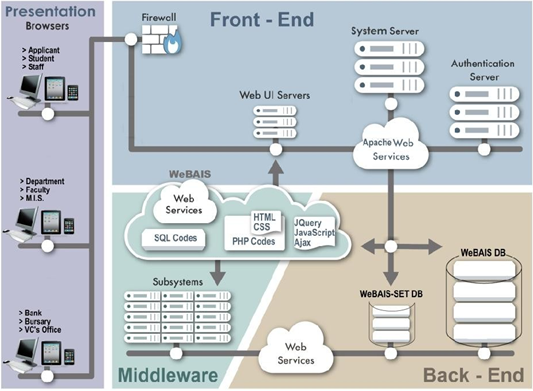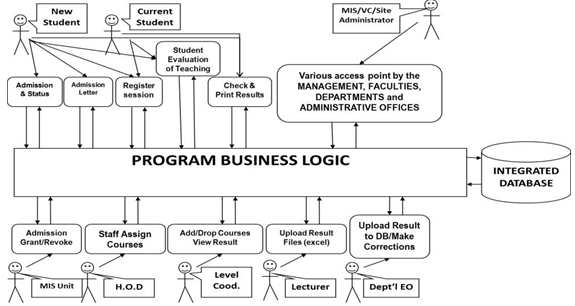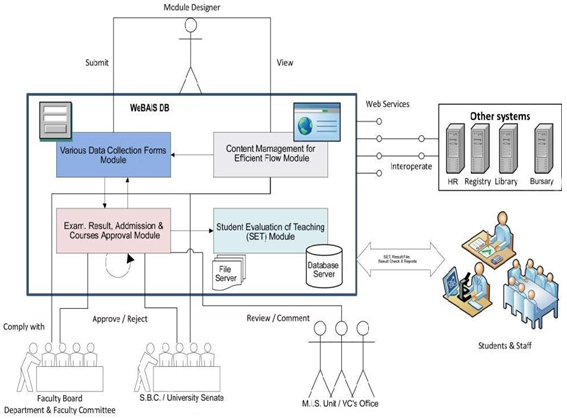SOFTWARE DEVELOPMENT FOR POST-PRIMARY EDUCATIONAL DATABASE
ABSTRACT
This research work highlighted the background definition of the database and database management system. It presents the need for a database in any ideal establishment including the effective control and management of information by appropriate software programs, in terms of the use of database management system is the cornerstone of management in any Endeavour… (Scroll down for the link to get the Complete Chapter One to Five Project Material)

INTRODUCTION
OVERVIEW OF THE PROJECT
Underdeveloped and developing countries have suffered a lot from the consequence of insufficient data or information, in most; consist of a matter of the inaudibility of data. The secret of any good management is based on organized, coordinated, and sufficient relevant data. This fact supports the idea of a database whose overriding importance is to provide relevant and sufficient data or information to the user.
According to French (2000), users earnestly desire far piece of information which would be of immense benefit to them in their business, therefore, buttress the fact that a database in any organization or establishment is very essential to the organization. In a database, data may be stored in which it may involve data directly which will provide descriptive information on the data they stored in the database and how to access them.
The term database is often used synonymously with information. A database is generally made up of data from a number of databases it could be a collection of related information… (Scroll down for the link to get the Complete Chapter One to Five Project Material)
Background of the Study
The study is centered on the administrative admissions and information management department. This project “software development for post-primary education database” is geared towards the needs and level of an adolescent. The main objective of this project is to implement the use of database management software on graduate on secondary school students who are academically competent, constructively self-directed, and who are oriented towards becoming productive, intelligent, sensitive, and mature citizens of this country Nigeria… (Scroll down for the link to get the Complete Chapter One to Five Project Material)
Statement of the Problem
Many government organizations and establishment, as well as some private establishment management and preservation and this, have seen a set back to them e.g. hospitals, schools, industries, and banks. The database and its management system have been known with the evolution of the compiler. Few organizations and establishments have come to the knowledge of this and utilize this concept and apply it while some other skill remains ignorant. It therefore in this ground that the administrative, admission and information management department post-primary educational database is viewed and studied under the following considerations;
- The number of application for administrations being on a geometric increase
- Slight delay in the processing of records due to the growing size and complexity of the establishment… (Scroll down for the link to get the Complete Chapter One to Five Project Material)
RESEARCH OBJECTIVE
On the one hand, the primary obligations of this study is to investigate and design a computer-based operating system in replacement of the present manual system of operating in by inculcating the efficiency of the database to information management and data processing in areas of data upkeep, retrieval validation, storing, updating and verification.
On the other hand, the researcher hopes to achieve the following;
- Speeding up the processing storing and retrieval of information.
- Improve decision making by reducing processing time as well as reducing the communication gap between the staff and the public.

LITERATURE REVIEW
Introduction
In the past, the computer was so in consequence that most people were scarcely aware of its existence. The machine used were mechanical devices; examples are the habits calculating machines developed by Gosfrre Wilhelm habit do to perform direct division and multiplication in 1671: (Scroll down for the link to get the Complete Chapter One to Five Project Material)
CONCEPT, FRAMEWORK, PRINCIPLES, AND PRACTICES
CONCEPT
- Database:
The database is collection-related information it is made up of data from a number of databases. Database management system (DBMS) is the software that permits an organization to centralize data, manage them efficiently, and provide access to the stored data by application programs.
According to Onyewuenyi R.N (1999), defined database as an electronic storehouse of information accessed by using a microcomputer, modern, and telephone also define as a collection of data usually on one then.
Oliver and Chapam’s (1996), viewed database as to contain any data that may be required just as a librarian has to Stan of books, some of which may be referred to.
A former university lecturer Dr. Lawrence .C. fejectkwu in the Daily Times (December 1995) reveal this research work title “braining the gap on Nigeria envisaged that one major hardship researcher often a software in Nigeria as an easy reference point of information gathering concerning the people of Nigeria, the value of human activity such as vital events the general characteristics by classification specific social and economic indices among other useful information that may be sought about the country or its people… (Scroll down for the link to get the Complete Chapter One to Five Project Material)
- The Data Definition Language:
The data definition language is a component of a database management system that defines each data element as it appears in the database before that data element is transmitted into the forms required by application programs. It is also the formal language used by programmers to specify the content and structure of the database. Dbase application packages examples are D base 14, Microsoft Access, and so forth.
At the national, we, the planning, building and projecting of any nation solely depend on available facts and figures hence the need for data. It was in this high that DANINADIS is Sunday champion of November (1991) questioned… (Scroll down for the link to get the Complete Chapter One to Five Project Material)
FRAMEWORK
As illustrated in the below diagram, the DBMS act as gross pay, the DBMS finds this item in the database and present it to the application program. Using traditional data files, the programmer would have to define the data then tell the compote where they are A DBMS eliminates most of the definitions state definitions find in traditional programs… (Scroll down for the link to get the Complete Chapter One to Five Project Material)
PRACTICE
In the united state of America (USA), there is a database that provides one with information on whatever subject needed. Some well-known database is the popular service, the don Jones never/rental service and Delphi that both specialize on business and information, the new York time information service and nixes that both specialize in new related information in any conscious society, manufacture firm rely on vital available data within specific market Jones of interest or the market protection for their products… (Scroll down for the link to get the Complete Chapter One to Five Project Material)
RESEARCH METHODOLOGY
Introduction
The success of conducting research work depends on the result that is gained by the researcher. These attained results are affected by the used methods to conduct research. In this way, the researcher used the two types of methods, interview methods, and questionnaire methods. The interview method is to collect data to reach the result of the research, and the questionnaire method to realize the need objective of the research
Source of Data Collection
The major source of data collection in this research work of software development on the post-primary education database system was obtained from antacid international secondary school.
Hence a secondary source f data is represented as an already made work obtained in the form of information from other work that has been documented.
Data Collection
The researcher employed the following method
- A) Interview method.
Information is sourced by staging a face to face conversation with people in a position to give relevant answers to questions about this project work. This involves a face to face contact of analysts and interviews to respond fine openly to question.
It gives the researcher room to get more feedback from the interview all information given is to the best of his (respondent) knowledge depending on where he can help. The information gotten in this case is reliable and accurate. The interview was conducted into served persons in the organization. They gave room for the description process and capture of necessary information being sought for.
- B) Questionnaire method: to actualized the need objective of this research the did not disregard the opinions of the workers and staff of different departments of the school. This tool is designed for the information of yes and no format and mostly applied in sudden situations if their method is accepted or when the researcher cannot constantly reach the respondents… (Scroll down for the link to get the Complete Chapter One to Five Project Material)
System Analysis
System analysis is defined as the process of breaking down a system (problem) into a subsystem and their component parts so as to analyze on detecting the information
Needs of a user and thereafter develop the system requirement system analysis, therefore, is the study of a business problem domain to recommend improvements and specify the business requirement for a solution. It is also the discussion of a system into species to study how they interact and work
The proposed system will create a good database for information management in the school. It will also help in the control of a good information system. The problem of the existing system will include;
- Lack of a computerized system is causing a delay in the cause of operations
- Lack of proper information… (Scroll down for the link to get the Complete Chapter One to Five Project Material)
RESEARCH FINDINGS AND DISCUSSION
Design is very important in interactive systems and needs to be evaluated at each stage of development. We followed the Iterative Design approach (Gould, 2000) which states that once a component has been partially or completely implemented, we can receive feedback from users. Based on that feedback we can find out problems in the design of the interface or problems in the functionality of the system, and re-evaluate alternatives. Our design has to take into account the various types of data and users in different applications.
We split our design into the system architecture, application architecture, data flow diagram (DFD), the web interface, the database, and the code. For DFD we applied DFD Standard using IS framework (Whitten & Bentley, 2008), for the design of the web interface, we applied User-Centered Design (Petrelli, et al 1999)… (Scroll down for the link to get the Complete Chapter One to Five Project Material)
A big challenge for the Educational database is that it needs to support a large number of users whose use for the system varies greatly. This challenge is a key factor that affects our design of system architecture and authentication.

Figure 4.1: System Architecture
The system architecture of Educational database is shown in Figure 4.1 User requests over the Internet are received by a web server, and the corresponding query is sent to a database server. The data are sent back to the webserver and the resulting web page is generated and sent back to the user. Our system runs in Windows with Apache (The Apache Software, 2007) and PHP for web serving and MySQL (SQL, n.d.) for the database. All functionality is written in PHP with MySQL API… (Scroll down for the link to get the Complete Chapter One to Five Project Material)
Another challenge for the Educational database is that it needs to cover a wide range of functionality for the different user – groups; as such the Application architecture needs to be modeled in line with the software specifications.

Figure 4.2: Application Architecture (Simple Application Logic).
Figure 4.2 shows the simple program flow for the main steps for different roles and how they interact with the system. The idea here is to create a role-based information system where each user has a specific role to play on the system. Most roles have been fully implemented with quantitative amounts of data for testing and assurance for the security and reliability of the system… (Scroll down for the link to get the Complete Chapter One to Five Project Material)

Figure 4.3: Application Architecture (User Group and Views)
Application with many users involved need careful designing, figure 4.3 shows how user – group are related and what are the new modules added from the previous work. Box labeled “A” is a content management module that is added from previous work to have efficient management of the system. Content management defined how all the system components will be interlinked and how will each content be identified uniquely so that only known contents go to a specific role… (Scroll down for the link to get the Complete Chapter One to Five Project Material)
CONCLUSION AND RECOMMENDATION
Conclusion
We presented a post-primary school Web-Based Academic Information System called Educational database. It was developed following the Information Science design paradigm, Software Engineering techniques, and Computer-Human Interaction guidelines. It is a robust, large-scale information system for Nigerian Post-primary school, a well-designed object-oriented application.
We also used the Student Evaluation of Teaching (SET), which is a tool to monitor and for the purpose of improving teaching performance by the teaching staff. This feature has not been implemented by any university digital system in Nigeria… (Scroll down for the link to get the Complete Chapter One to Five Project Material)
Recommendation
The educational database only implements some aspects of Academic Activities of University. It has not covered all aspects of university activities that are part of academics. It has not also included many administrative activities. Below are some of these activities that have not been included:
(Scroll down for the link to get the Complete Chapter One to Five Project Material)

REFERENCES
Baecker, R., Grudin, J., Buxton, W., and Greenberg, S. (2005). Readings in Human-Computer Interaction: Toward the Year 2000. New York: Morgan Kaufmann Publishers Inc. 2nd Edition.
Baecker, R., J.Grundin, Buxton, W., and Greenbergs, S. (2000). Reading in Human-computer Interaction. New York, 1.
Bharamagoudar, S., Geeta, R., and Totad, S. (2013). Web-Based Student Information Management System. International Journal of Advanced Research in Computer and Communication Engineering Vol. 2, 2343. (Software Development)(Software Development)(Software Development)(Software Development)(Software Development)
Chen, P.P.S. (1976). The Entity-relationship Model Toward a Unified View of Data. ACM Transactions on Database Systems, 9-36. (Software Development)(Software Development)(Software Development)(Software Development)(Software Development)(Software Development)(Software Development)(Software Development)
Chen, Y., and Hoshower, L. B. (2003). Student Evaluation of Teaching Effectiveness: An assessment of student perception and motivation. Assessment and Evaluation in Higher Education, Vol. 28, No. 1, 71. (Software Development)(Software Development)(Software Development)(Software Development)(Software Development)
Crowston, K., and Malone, T. (1994). The Interdisciplinary Study of Coordination. ACM Computing Surveys, 119. (Software Development)(Software Development)(Software Development)(Software Development)
(Scroll down for the link to get the Complete Chapter One to Five Project Material)

